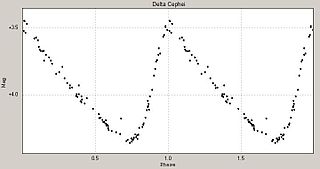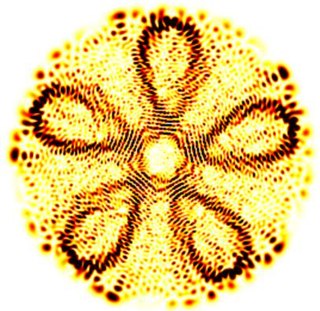Related Research Articles

In chaos theory, the butterfly effect is the sensitive dependence on initial conditions in which a small change in one state of a deterministic nonlinear system can result in large differences in a later state.

A photon is an elementary particle that is a quantum of the electromagnetic field, including electromagnetic radiation such as light and radio waves, and the force carrier for the electromagnetic force. Photons are massless, so they always move at the speed of light in vacuum, 299792458 m/s. The photon belongs to the class of bosons.

Loop quantum gravity (LQG) is a theory of quantum gravity, which aims to merge quantum mechanics and general relativity, incorporating matter of the Standard Model into the framework established for the pure quantum gravity case. It is an attempt to develop a quantum theory of gravity based directly on Einstein's geometric formulation rather than the treatment of gravity as a force. As a theory LQG postulates that the structure of space and time is composed of finite loops woven into an extremely fine fabric or network. These networks of loops are called spin networks. The evolution of a spin network, or spin foam, has a scale above the order of a Planck length, approximately 10−35 meters, and smaller scales are meaningless. Consequently, not just matter, but space itself, prefers an atomic structure.

Quantum chaos is a branch of physics which studies how chaotic classical dynamical systems can be described in terms of quantum theory. The primary question that quantum chaos seeks to answer is: "What is the relationship between quantum mechanics and classical chaos?" The correspondence principle states that classical mechanics is the classical limit of quantum mechanics, specifically in the limit as the ratio of Planck's constant to the action of the system tends to zero. If this is true, then there must be quantum mechanisms underlying classical chaos. If quantum mechanics does not demonstrate an exponential sensitivity to initial conditions, how can exponential sensitivity to initial conditions arise in classical chaos, which must be the correspondence principle limit of quantum mechanics?
The classical limit or correspondence limit is the ability of a physical theory to approximate or "recover" classical mechanics when considered over special values of its parameters. The classical limit is used with physical theories that predict non-classical behavior.
The Immirzi parameter is a numerical coefficient appearing in loop quantum gravity (LQG), a nonperturbative theory of quantum gravity. The Immirzi parameter measures the size of the quantum of area in Planck units. As a result, its value is currently fixed by matching the semiclassical black hole entropy, as calculated by Stephen Hawking, and the counting of microstates in loop quantum gravity.
Semiclassical gravity is the approximation to the theory of quantum gravity in which one treats matter fields as being quantum and the gravitational field as being classical.
The old quantum theory is a collection of results from the years 1900–1925 which predate modern quantum mechanics. The theory was never complete or self-consistent, but was rather a set of heuristic corrections to classical mechanics. The theory is now understood as the semi-classical approximation to modern quantum mechanics. The main and final accomplishments of the old quantum theory were the determination of the modern form of the periodic table by Edmund Stoner and the Pauli Exclusion Principle which were both premised on the Arnold Sommerfeld enhancements to the Bohr model of the atom.
In physics and astronomy, Euler's three-body problem is to solve for the motion of a particle that is acted upon by the gravitational field of two other point masses that are fixed in space. This problem is exactly solvable, and yields an approximate solution for particles moving in the gravitational fields of prolate and oblate spheroids. This problem is named after Leonhard Euler, who discussed it in memoirs published in 1760. Important extensions and analyses were contributed subsequently by Lagrange, Liouville, Laplace, Jacobi, Darboux, Le Verrier, Velde, Hamilton, Poincaré, Birkhoff and E. T. Whittaker, among others.

A dynamical billiard is a dynamical system in which a particle alternates between free motion and specular reflections from a boundary. When the particle hits the boundary it reflects from it without loss of speed. Billiards are Hamiltonian idealizations of the game of billiards, but where the region contained by the boundary can have shapes other than rectangular and even be multidimensional. Dynamical billiards may also be studied on non-Euclidean geometries; indeed, the first studies of billiards established their ergodic motion on surfaces of constant negative curvature. The study of billiards which are kept out of a region, rather than being kept in a region, is known as outer billiard theory.
In mathematics, integrability is a property of certain dynamical systems. While there are several distinct formal definitions, informally speaking, an integrable system is a dynamical system with sufficiently many conserved quantities, or first integrals, such that its behaviour has far fewer degrees of freedom than the dimensionality of its phase space; that is, its evolution is restricted to a submanifold within its phase space.

A quantum point contact (QPC) is a narrow constriction between two wide electrically conducting regions, of a width comparable to the electronic wavelength.
In physics and mathematics, the Hadamard dynamical system is a chaotic dynamical system, a type of dynamical billiards. Introduced by Jacques Hadamard in 1898, and studied by Martin Gutzwiller in the 1980s, it is the first dynamical system to be proven chaotic.
The Einstein–Brillouin–Keller method (EBK) is a semiclassical method used to compute eigenvalues in quantum-mechanical systems. EBK quantization is an improvement from Bohr-Sommerfeld quantization which did not consider the caustic phase jumps at classical turning points. This procedure is able to reproduce exactly the spectrum of the 3D harmonic oscillator, particle in a box, and even the relativistic fine structure of the hydrogen atom.

Davydov soliton is a quantum quasiparticle representing an excitation propagating along the protein α-helix self-trapped amide I. It is a solution of the Davydov Hamiltonian. It is named for the Soviet and Ukrainian physicist Alexander Davydov. The Davydov model describes the interaction of the amide I vibrations with the hydrogen bonds that stabilize the α-helix of proteins. The elementary excitations within the α-helix are given by the phonons which correspond to the deformational oscillations of the lattice, and the excitons which describe the internal amide I excitations of the peptide groups. Referring to the atomic structure of an α-helix region of protein the mechanism that creates the Davydov soliton can be described as follows: vibrational energy of the C=O stretching oscillators that is localized on the α-helix acts through a phonon coupling effect to distort the structure of the α-helix, while the helical distortion reacts again through phonon coupling to trap the amide I oscillation energy and prevent its dispersion. This effect is called self-localization or self-trapping. Solitons in which the energy is distributed in a fashion preserving the helical symmetry are dynamically unstable, and such symmetrical solitons once formed decay rapidly when they propagate. On the other hand, an asymmetric soliton which spontaneously breaks the local translational and helical symmetries possesses the lowest energy and is a robust localized entity.

In quantum chaos, a branch of mathematical physics, quantum ergodicity is a property of the quantization of classical mechanical systems that are chaotic in the sense of exponential sensitivity to initial conditions. Quantum ergodicity states, roughly, that in the high-energy limit, the probability distributions associated to energy eigenstates of a quantized ergodic Hamiltonian tend to a uniform distribution in the classical phase space. This is consistent with the intuition that the flows of ergodic systems are equidistributed in phase space. By contrast, classical completely integrable systems generally have periodic orbits in phase space, and this is exhibited in a variety of ways in the high-energy limit of the eigenstates: typically, some form of concentration occurs in the semiclassical limit .

Stellar pulsations are caused by expansions and contractions in the outer layers as a star seeks to maintain equilibrium. These fluctuations in stellar radius cause corresponding changes in the luminosity of the star. Astronomers are able to deduce this mechanism by measuring the spectrum and observing the Doppler effect. Many intrinsic variable stars that pulsate with large amplitudes, such as the classical Cepheids, RR Lyrae stars and large-amplitude Delta Scuti stars show regular light curves.

A unified model for Diffusion Localization and Dissipation (DLD), optionally termed Diffusion with Local Dissipation, has been introduced for the study of Quantal Brownian Motion (QBM) in dynamical disorder. It can be regarded as a generalization of the familiar Caldeira-Leggett model.

Quantum scarring refers to a phenomenon where the eigenstates of a classically chaotic quantum system have enhanced probability density around the paths of unstable classical periodic orbits. The instability of the periodic orbit is a decisive point that differentiates quantum scars from the more trivial observation that the probability density is enhanced in the neighborhood of stable periodic orbits. The latter can be understood as a purely classical phenomenon, a manifestation of the Bohr correspondence principle, whereas in the former, quantum interference is essential. As such, scarring is both a visual example of quantum-classical correspondence, and simultaneously an example of a (local) quantum suppression of chaos.

Sudhir Ranjan Jain is an Indian theoretical physicist at Bhabha Atomic Research Centre, Mumbai, known for his contributions in complex quantum systems and Nonlinear dynamics. He is a scientist at the nuclear physics division of Bhabha Atomic Research Centre, professor at Homi Bhabha National Institute and adjunct professor at the Centre for Excellence in Basic Sciences. He authored Mechanics, Waves and Thermodynamics: An Example-based Approach. His doctoral advisor was Prof. Suresh V. Lawande who was a student of Edward Teller.
References
- ↑ Dana, I. (1993). "Type specification of chaos". Physical Review Letters. 70 (16): 2387–2390. Bibcode:1993PhRvL..70.2387D. doi:10.1103/PhysRevLett.70.2387. PMID 10053549.
- ↑ Reinhardt, W. P. (1982). "Chaotic dynamics, semiclassical quantization, and mode-mode energy transfer: The Boulder view". The Journal of Physical Chemistry. 86 (12): 2158–2165. doi:10.1021/j100209a008.
- ↑ Shirts, R. B. (1982). "Approximate constants of motion for classically chaotic vibrational dynamics: Vague tori, semiclassical quantization, and classical intramolecular energy flow". The Journal of Chemical Physics. 77 (10): 5204–5217. Bibcode:1982JChPh..77.5204S. doi:10.1063/1.443697.